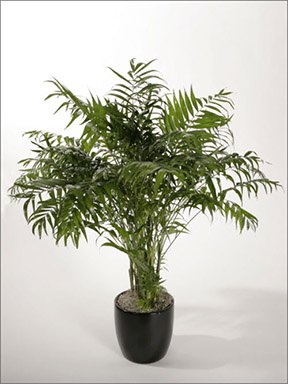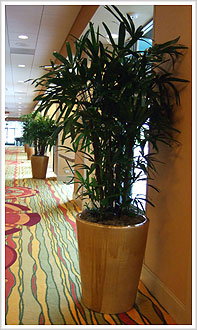Common Name: Fishtail palm
Light Needs
Adaptive to low and high light
Water Requirements
Water thoroughly
Description:
Stately, long-living palm that grows to 20 feet over time. The feathery triangular leaflets look like fishtails and are even a bit scaly.
Most commonly used varieties: Caryota urens
Caryota mitis is easily distinguished by its gracefully arching exotic foliage. Each frond sports deep-green, saw-tooth edged leaflets resembling fishtails. Native to Southeast Asia, it is a reliable and hardy indoor plant, that can reach a mature height of 35-40 feet, with a canopy of 20-feet-wide. Like most plants in the palm family, the trunk tissues of fishtail palms resemble herbaceous grasses rather than trees. Caryota translocates water and nutrients by means of a series of vascular bundles scattered throughout the trunk tissue. Caryota produce bipinnately compound leaves. Each leaf has a central rachis stem, with leaflets radiating out on either side – much like a feather. The leaflets further divide into smaller stems with their own leaflets.
Caryota will tolerate a wide range of light, low humidity and fluctuating temperatures if maintained correctly. Although they prefer bright indirect or filtered light, fishtail palms can successfully acclimate to much lower light (80fc).
Caryota Mitis are fast growers and need quite a bit more water than most other palms. When we see these palms in their native environment or in atriums you will notice that they like to have their soil moist. In fact, they like to be quite a bit moister than most other palms. They have a large root system and demand water year round. It’s important that the entire root ball is watered thoroughly, not just the surface. Soak them through to the saucer. Be careful because water may run through fast due to the large root system.
On the other hand, too much water combined with low light levels can lead to browning from overwatering. This leaf edge browning will appear dark brown with a dash of yellow and will look a bit “wet.” This leaf damage typically happens to Caryotas that are in lower or only artificial light areas. These plants will be growing very slowly and demand much less water than those in full light. Keep their soil moist, but not wet and don’t leave them standing in water or the roots will rot.
Another catch to caring for Caryotas is our city water. Fluoride is not their friend. It burns the tips of the fronds of fishtails. Do what you can to help prevent fluoride build-up.
Caryotas will benefit from cleaning. Keep them healthy and clean by an occasional misting with water. Don’t use leaf shine as the chemicals will damage them. Besides, palms aren’t supposed to be shiny, they should have a dull finish is a natural look. Fertilize at least four times a year for those in good light and they will grow with vigor. For those in low light, skip the fertilizer altogether for the first year after installation and feed in half doses only if the plant begins to pale after that. These jewels can live for long periods in the same pot but will benefit from some fresh soil being added every two to three years. They may split their pots after three years or so.
Caryotas mitis prefer high humidity and suffer a bit when the levels get low. Often this can result in a bit of browning on the edges of the fronds. This browning will characteristically be crispy light brown at the edge for the foliage.
Fertilize at least four times a year for those in good light and they will grow with vigor. For those in low light, skip the fertilizer completely for the first year after installation and feed in half-dose only if the plant begins to pale after that.
These jewels can live forever in the same pot, but will benefit from some fresh soil being added every two to three years.
If they begin to get too wide for the space, discretely add a dark brown “belt” made of twine about 18” from the soil line to reduce the spread. Done well, this support should be invisible to your client. Never stake these plants for this looks terrible and unnatural. To grow a fuller, bushier plant, you can remove the tallest frond, which will encourage the plant to start growing new suckers from its base.
Spider mites can be a real problem for fishtails. Scale insects are also sometimes a problem. Watch carefully for any sign of these pests and start spraying and hand removing them as soon as you notice them. Mites can carry off a fishtail quickly so always suspect that they are there and make weekly inspections. Water with Pro-tekt weekly to give added protection from insects.



